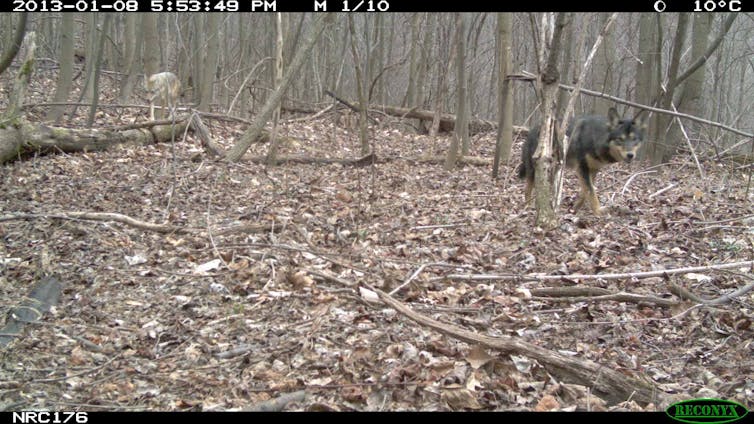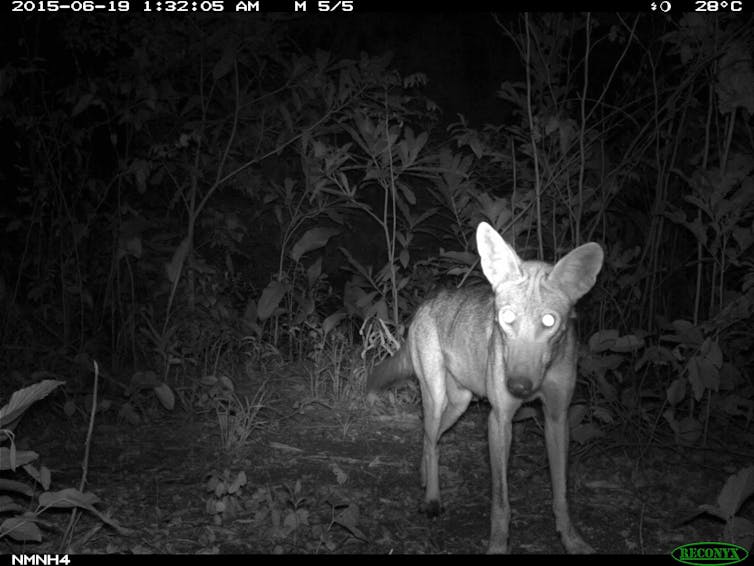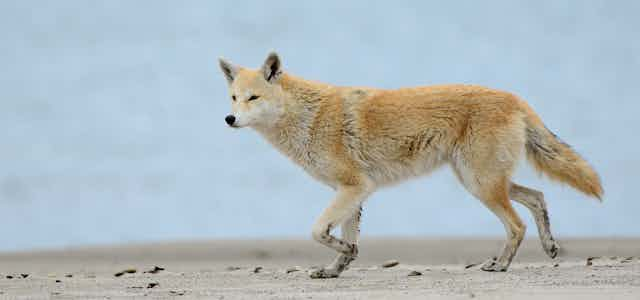Talk of “coywolves” – a blend of coyote and wolf – is everywhere. There is a PBS special called Meet the Coywolf, a recent article in the Economist, and it is now trending on Facebook. The media really love this new animal name.
There is no doubt that there is a hybrid canid living in the eastern US, and that it is the result of an amazing evolution story unfolding right underneath our noses.
However, this is not a new species – at least not yet – and I don’t think we should start calling it a “coywolf.”
Genetic swapping
What creature are we talking about? In the last century, a predator – I prefer the name “eastern coyote” – has colonized the forests of eastern North America, from Florida to Labrador.
New genetic tests show that all eastern coyotes are actually a mix of three species: coyote, wolf and dog. The percentages vary, dependent upon exactly which test is applied and the geographic location of the canine.
Coyotes in the Northeast are mostly (60%-84%) coyote, with lesser amounts of wolf (8%-25%) and dog (8%-11%). Start moving south or east and this mixture slowly changes. Virginia animals average more dog than wolf (85%:2%:13% coyote:wolf:dog) while coyotes from the Deep South had just a dash of wolf and dog genes mixed in (91%:4%:5% coyote:wolf:dog). Tests show that there are no animals that are just coyote and wolf (that is, a coywolf), and some eastern coyotes that have almost no wolf at all.
In other words, there is no single new genetic entity that should be considered a unique species. Instead, we are finding a large intermixing population of coyotes across the continent, with a smattering of noncoyote DNA mixed in to varying degrees along the eastern edge. The coywolf is not a thing.

All eastern coyotes show some evidence of past hybridization, but there is no sign that they are still actively mating with dogs or wolves. The coyote, wolf and dog are three separate species that would very much prefer not to breed with each other. However, biologically speaking, they are similar enough that interbreeding is possible.
This genetic swapping has happened more than once in their history; one study showed that the gene for black coat color found in North American wolves and coyotes today (but not in Old World wolves) originated in dogs brought to the continent by the earliest Native Americans. Some prehistoric hybridization event transferred the dog gene into wild wolves and coyotes.
The eastern coyote is born
We can estimate the date of the most recent hybridization events that created eastern coyotes by analyzing their genetic structure. Their DNA show that about 100 years ago, coyotes mated with wolves, and about 50 years ago with dogs. A century ago, wolf populations in the Great Lakes were at their nadir, living at such low density that some reproductive animals probably couldn’t find another wolf mate, and had to settle with a coyote.
The more recent date for the dog hybridization likely results from a cross-species breeding event at the very leading edge of the wave of colonizing coyotes in the east, possibly after a few females first spanned the St Lawrence seaway into upstate New York, where they would have encountered abundant feral dogs, but no other coyotes.

Nowadays, eastern coyotes have no problem finding a coyote mate. Their populations continue to grow throughout their new forested range, and they seem more likely to kill a dog than breed with it. Wolf populations in the Great Lakes have also recovered, and the wolf is once again the worst enemy of the coyote, rather than its last-chance prom date.
Coyotes have also expanded north into Alaska, although there is no sign of hybridization in that range extension. In Central America, they have expanded out of Mexico’s deserts, working their way south past the Panama Canal in the last decade, apparently bound for South America.
No genetic studies have looked at Central American coyotes, but photographs of doglike animals suggest that coyotes might be mixing it up across species lines along the leading edge of this southward expansion as well.
Coywolfdog evolution
Hybridization across species is a natural evolutionary phenomenon. The old notion that an inability to breed should define what a species is has been abandoned by zoologists (with a resounding “I told you so” from botanists). Even modern humans are hybrids, with traces of Neanderthal and Denisovan genes mixed into our genome.
The first requirement for evolution is variation, and mixing genes from two species creates all sorts of new variations for evolution to act on. Most of these probably die, being a compromise between two longstanding species that were already well-adapted to their own niches.
However, in today’s rapidly changing world, new variations might actually do better than the old types. Some of these genetic mixes will survive better than others – this is natural selection.
The coyote with a bit of wolf genes to make it slightly larger was probably better able to handle deer, which are overabundant in eastern forests, but still wily enough to live in a landscape full of people. These animals thrived, dispersed east and thrived again, becoming the eastern coyote.
Exactly which dog and wolf genes are surviving natural selection in today’s eastern coyote is an area of active research.
Coyotes with odd coat colors or hair types are probably the most conspicuous sign of dog genes in action, while their slightly larger size might come from wolf genes. Some of these genes will help an animal survive and breed; others will make them less fit. Natural selection is still sorting this out, and we are witnessing the evolution of a new type of coyote right under our noses, one that is very good at living there.
Western coyotes adapt locally to their environments, with limited gene flow between populations (called “ecotypes”) living in different habitats, presumably reflecting local specialization.
Will eastern coyotes specialize locally as well? How will dog and wolf genes sort out across cities and wildernesses of the east?
Expect some really cool science in the next few years as researchers use modern genetic tools to sniff out the details of this story.
Evolution still in progress
There are many examples of bad animal names that cause a lot of confusion.
The fisher is a large type of weasel that does not eat fish (it prefers porcupines). The mountain beaver of the Pacific Northwest is not a beaver and does not live in the mountains. And then there’s the sperm whale…
We don’t get many opportunities to name new animals in the 21st century. We shouldn’t let the media mess up this one by declaring it a new species called the coywolf. Yes, there are wolf genes in some populations, but there are also eastern coyotes with almost no wolf genes, and others that have as much dog mixed in as they do wolf. “Coywolf” is an inaccurate name that causes confusion.
The coyote has not evolved into a new species over the last century. Hybridization and expansion have created a host of new coyote variations in the east, and evolution is still sorting these out. Gene flow continues in all directions, keeping things mixed up, and leading to continual variation over their range, with no discrete boundaries.
Could evolution eventually lead to a coyote so specialized for eastern forests that they would be considered a unique species? Yes, but for this to happen, they would have to cut off gene flow with nonhybrid animals, leading to distinct types of coyotes that (almost) never interbreed. I think we are a long way from this possibility.
For now, we have the eastern coyote, an exciting new type of coyote in the midst of an amazing evolutionary transition. Call it a distinct “subspecies,” call it an “ecomorph,” or call it by its scientific name Canis latrans var. But don’t call it a new species, and please, don’t call it the coywolf.

